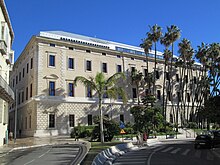art.wikisort.org - Museum
The Museo de Málaga is a museum in Málaga, Andalusia, Spain. Formed in 1973, it brought together the former Museo Provincial de Bellas Artes (Provincial Museum of Fine Arts), born in 1913, and Museo Arqueológico Provincial (Provincial Archeological Museum), born in 1947. As of 2010, the museum remains institutionally divided into two "sections" corresponding to the older museums.[1] There are slightly over 2,000 pieces in the Fine Arts collection and over 15,000 in the Archeology collection.[2] The museum opened to the public in December 2016, becoming the biggest museum in Andalusia and the 5th in Spain.[3]

Fine Arts section
The Fine Arts section has its origin in the Royal Decree of 24 July 1913 that encouraged the Ministry of Public Instruction to establish provincial fine arts museums in those provincial capitals that did not yet have such an institution. Málaga's Real Academia de Bellas Artes de San Telmo ("San Telmo Royal Academy of Fine Arts") had long wished to create such an institution. The Museo Provincial de Bellas Artes was founded 3 February 1915 and opened its doors in a temporary location in the Calle Pedro de Toledo 17 August 1916.[1] In 1920 it moved to the former Jesuit college of San Sebastián, which also housed the Academy and a school of fine arts.[1][4] It moved to the Buenavista Palace in 1961, but had to leave that facility in 1997 when the Andalusian Autonomous Government bought the palace to convert it into the Museo Picasso Málaga. At that time the Fine Arts section moved to the Palacio de la Aduana, where temporary exhibitions have been held.[1]
The museum includes works by Luis de Morales, Luca Giordano, Bartolomé Esteban Murillo, Antonio del Castillo, Alonso Cano, Pedro de Mena, Jusepe de Ribera, Francisco de Zurbarán, Diego Velázquez, Francisco de Goya, Federico de Madrazo, Ramón Casas, José Moreno Carbonero, Enrique Simonet, Joaquín Sorolla, Léon Bonnat, Franz Marc and Pablo Picasso.[5][6]
- El Juicio de Paris (The Judgment of Paris, 1904), Enrique Simonet.
- Anatomia del corazón (Heart's Anatomy, 1890), Enrique Simonet.
- The martyrdom of Saint Bartholomew, circa 1641.
(attributed to Jusepe de Ribera)
Archeological section

The Archeological section has its origin in a Decree of 1947, integrating the collections of the old Museo Loringiano (based on the 19th-century collection of the Marquesses of Casa-Loring) and the archeological holdings of the Museo Provincial de Bellas Artes. The latter came from digs that had occurred in the province since the 1930s, including digs in the Alcazaba of Málaga, where the new museum opened in 1949. In 1996, rehabilitation of the Alcazaba required a move. The collection was temporarily housed in the 16th-century Convento de la Trinidad until 1999, when it moved to the former provincial historical archive in the Avenida de Europa, which it shares with the Biblioteca Pública del Estado ("State Public Library"). Before the museum opened, there was a series of temporary exhibitions at the Palacio de la Aduana.[1]
See also
- List of museums in Málaga
- List of museums in Spain
Notes
- Museo de Málaga: Historia, Museo de Málaga. Accessed online 2010-01-19.
- Rafael Puertas Tricas, El Uso Museístico del Palacio de la Aduana, Revista Jábega (Centro de Ediciones de la Diputación de Málaga), Number 92, 2002, 5:13. p. 8–9 (p. 4–5 of PDF). Accessed online 2010-01-19.
- "La apertura de la Aduana confirma a Málaga como "capital de los museos"". sevilla (in European Spanish). 2016-12-12. Retrieved 2017-01-24.
- Sede Archived 2010-02-01 at the Wayback Machine, Ateneo de Málaga. Accessed online 2010-01-17
- An older, French-language guide to Málaga Archived 2010-10-15 at the Wayback Machine (accessed online 2010-01-17) lists works by de Morales, Luca Giordano, Murillo, Antonio dei Castillo, Alonso Cano, de Ribera, Zurbarán, José Moreno Carbonero, Simonet, and the altarpiece attributed to Pedro de Mena, and the early Picassos.
- Monumentos de Málaga Archived 2011-07-18 at the Wayback Machine, webmalaga.com, accessed online 2010-01-17, lists Murillo, Zurbarán, Morales, Alonso Cano, Ribera, Luca Giordano, Sorolla, Martínez Cubells, Picasso, and singles out the collection of 19th-century painters, mentioning in particular Muñoz Degrain, Simonet, and Nogales (presumably Avelino Nogales).
External links
 Media related to Museo de Málaga at Wikimedia Commons
Media related to Museo de Málaga at Wikimedia Commons- Museo de Málaga, official English-language site.
На других языках
[de] Museum von Málaga
Das Museum von Málaga (spanisch Museo de Málaga) ist das größte Museum der südspanischen Region Andalusien; es befindet sich im Gebäude der ehemaligen Zollverwaltung (spanisch Palacio de la Aduana) und vereint seit dem Jahr 2016 zwei bisher getrennt untergebrachte Sammlungen.- [en] Museo de Málaga
[es] Museo de Málaga
El Museo de Málaga es un centro expositivo de la ciudad española de Málaga que da cabida a las colecciones de dos instituciones museísticas malacitanas, el Museo de Bellas Artes de Málaga y el Museo Arqueológico Provincial de Málaga, contando con más de 15.000 referencias en arqueología y una amplia colección pictórica de 2000 obras producidas entre los siglos XIX y XX. Es el quinto museo más grande de España y el mayor de Andalucía.[3][fr] Musée de Malaga
Le musée de Malaga (en espagnol : Museo de Málaga) est un musée d'arts et d'archéologie situé à Malaga en Andalousie, en Espagne.[ru] Малагский музей
Малагский музей (исп. Museo de Málaga) — художественный и археологический музей в Малаге. Появился в результате объединения двух провинциальных музеев — музея изящных искусств и археологического музея. Музейное учреждение по-прежнему сохраняет два отдела — художественный и археологический. Фонд художественного отдела Малагского музея насчитывает более двух тысяч предметов, археологического — более 15 тысяч.Другой контент может иметь иную лицензию. Перед использованием материалов сайта WikiSort.org внимательно изучите правила лицензирования конкретных элементов наполнения сайта.
WikiSort.org - проект по пересортировке и дополнению контента Википедии


